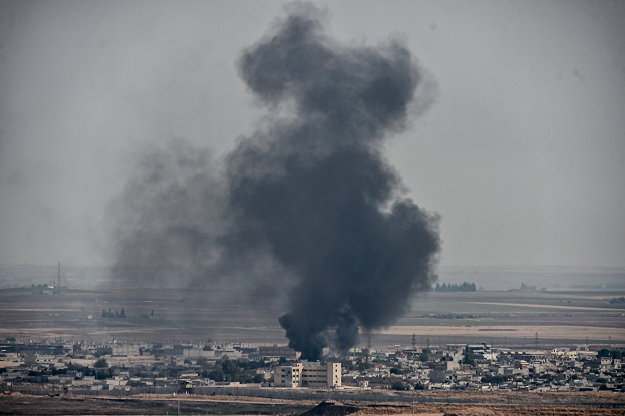
On October 9, 2019, Turkish President Recep Tayyip Erdogan launches operation "Peace Spring" against Kurdish-led forces in Syria.
He says the offensive targets the "terrorists" of the Kurdish People's Protection Units (YPG) militia and the militant Islamic State (IS) group.
Erdogan also wants to establish a "safe zone" on the Syrian side of the border where Turkey could send back some of the 3.6 million refugees it hosts from the eight-year-old civil war.
The border towns of Ras al-Ain and Tal Abyad both come under heavy Turkish air bombardment. The ground offensive begins hours later.
Pakistan backs Turkey on military operation in Syria
United States (US) President Donald Trump calls the Turkish incursion a "bad idea".
Yet it is Washington's withdrawal two days earlier of US troops in northern Syria near the Turkish border that clears the way for the offensive.
Several countries including many in Europe express concern for civilians in the targeted areas. Fears that the militants detained by the Kurds could escape are also widespread.
The next day Turkish forces escalate their bombardment as the YPG-dominated Syrian Democratic Forces (SDF) fight to halt their advance.
Kurdish officials say five IS prisoners have escaped from a facility in the border city of Qamishli housing mostly foreign militants after shelling nearby.
The Kurdish administration says some 12,000 men are held in seven detention centres across Kurdish-controlled areas.
Turkey, Russia, Iran must take more responsibility for Syria peace: Erdogan
On October 13, Kurdish authorities say nearly 800 relatives of foreign members of IS have escaped from a displacement camp at Ain Issa.
That same day Turkish forces and their proxies seize the key border town of Tal Abyad, according to the Syrian Observatory for Human Rights war monitor.
In the evening the Kurdish administration, which accuses Washington of having abandoned them, announces a deal with the Damascus government on a Syrian troop deployment near the border with Turkey.
On October 14, the Syrian regime sends troops towards the border. The next day they take full control of Manbij. Russian troops patrol the area to prevent Turkish-Syrian clashes.
On the 16th, Erdogan urges Kurdish forces to lay down arms and retreat from northern Syria. He dismisses calls for a ceasefire from Trump, who has sent his Vice President Mike Pence and Secretary of State Mike Pompeo to Turkey.
Erdogan renews Syria 'air and ground' operation threat
Syrian regime troops and Russian soldiers deployed in the key border town of Kobane.
The UN Security Council warns of a risk of "dispersion" of militant prisoners.
Trump denies that he had given Erdogan a "green light" for the offensive. He says the Kurdish rebels PKK, who have waged a decades-long insurgency in Turkey, were "probably" a bigger terror threat than the IS group.
On October 17, fighting continues to rage, especially in Ras al-Ain, where Turkish troops control half the territory, according to the Observatory. Kurdish authorities call for a humanitarian corridor to evacuate civilians from the town.
Pence announces ceasefire deal with Erdogan to end Turkey's Syria offensive
Syrian President Bashar al-Assad says his forces will counter Turkey's invasion by "all legitimate means".
The Observatory says nearly 500 people have been killed, including dozens of civilians, and more than 300,000 people displaced during the offensive.
The Kurdish authorities accuse Turkey of using banned weapons such as napalm. Ankara denies the charge.
After meeting Erdogan, Pence says Turkey has agreed to suspend its offensive for five days and will end the assault if Kurdish-led forces withdraw from northern Syria. He says Trump will withdraw sanctions on Turkey after a permanent ceasefire.
Ankara confirms the suspension.
Trump hails a "great day" for Turkey and the Kurds.



1725030039-0/Untitled-design-(2)1725030039-0-165x106.webp)
1725366721-0/kyle-(1)1725366721-0-165x106.webp)



1732707402-0/Untitled-design-(8)1732707402-0-270x192.webp)








COMMENTS
Comments are moderated and generally will be posted if they are on-topic and not abusive.
For more information, please see our Comments FAQ